Ever turned your key and heard your engine struggle to start? Those tiny components called spark plugs might be the culprits. These small but mighty parts create the essential spark that ignites fuel in your engine, powering your vehicle forward with each turn of the key.
When these vital components wear out, your car’s performance suffers. You might notice rough idling, difficulty starting, or even decreased fuel economy. Regular maintenance keeps your vehicle running smoothly and helps avoid costly repairs down the road.
This comprehensive guide walks you through every step of changing spark plugs in your vehicle. Whether you’re a weekend mechanic looking to save money or simply want to understand what happens during this maintenance procedure, we’ve got you covered.
You’ll discover why these components are crucial for performance, when they need replacing, and get detailed instructions for various models. By the end, you’ll have the confidence to tackle this task yourself or better understand what your mechanic is doing when servicing your car.
Let’s dive into the world of engine maintenance and learn how proper care ensures optimal performance, better fuel economy, and reliable starting in all conditions.
Understanding the Importance of Spark Plugs in Your Toyota
At the heart of your Toyota’s engine is a key part: the spark plug. These small but crucial devices ignite the fuel-air mix that powers your car. Without them, your Toyota won’t run well or might not run at all.
Spark plugs are vital to your car’s secondary ignition system. They spark the air/fuel mix in your engine’s chambers. The high voltage from the ignition coil jumps across the spark plug’s gap, igniting your Toyota.
Regular Toyota spark plug maintenance keeps your engine running smoothly. Worn-out spark plugs can lead to many problems, affecting your drive and your car’s life.
How Spark Plugs Affect Engine Performance
Your Toyota’s performance depends on its spark plugs. Good spark plugs ensure complete combustion, leading to:
- Optimal power and quick acceleration
- Better fuel economy and lower emissions
- Smooth engine operation at all speeds
- Reliable starting in cold weather
When spark plugs work right, they provide the right energy at the right time. This is key for your Toyota’s power, torque, and throttle response. Even a small problem with spark plugs can cause power loss and lower fuel efficiency.
Signs of Failing Spark Plugs in Toyota Vehicles
Your Toyota will show signs when spark plugs start to fail. Spotting these early can prevent bigger engine issues:
- Engine misfires or hesitates when accelerating
- Rough idling at traffic lights
- Hard starting, especially in cold weather
- More fuel used without driving differently
- Engine surges or runs rough at high speeds
You might see the check engine light on or notice your car’s performance drop. These tips can help you catch problems before they cost more. Different Toyotas show these signs differently, but all need spark plug care.
When to Perform Toyota Spark Plug Replacement
Knowing when to replace Toyota spark plugs is key. Modern cars, including Toyotas, use better materials that last longer. It’s important to check your car’s manual for the right time to replace them.
Recommended Replacement Intervals by Toyota Model
Toyota’s spark plug change times vary by car model. Old spark plugs needed to be changed every 30,000 miles. But, new ones can go up to 120,000 miles, depending on your car and how you drive.
Driving in the city means changing spark plugs sooner than driving on the highway. Your car’s manual will tell you the best time for your specific model.
Camry, Corolla, and RAV4 Models
Newer Camry, Corolla, and RAV4 models (2010 and later) use iridium spark plugs. They should be replaced every 100,000-120,000 miles. Older models or those with regular spark plugs need to be changed every 60,000 miles.
Tacoma, Tundra, and 4Runner Models
Trucks and SUVs like Tacoma, Tundra, and 4Runner need spark plug changes every 60,000-90,000 miles. Their V6 and V8 engines work harder, so spark plugs might not last as long as in sedans.
Lexus Toyota Models
Lexus cars, Toyota’s luxury line, use high-quality iridium spark plugs. They should be replaced every 100,000-120,000 miles. But, high-performance models like the IS F or RC F might need spark plug changes every 60,000 miles.
Warning Signs That Indicate Immediate Replacement
If your Toyota shows signs of bad spark plugs, don’t wait. Engine misfires or hesitation when accelerating are big red flags. Also, if your car uses more fuel or is hard to start, it’s time to check the spark plugs.
Just looking at your spark plugs can tell you if they need to be replaced. Healthy plugs are light tan or grayish. If you see black, sooty deposits or white, chalky plugs, it’s time to replace them.
- Black, sooty deposits (indicates rich fuel mixture)
- White, chalky appearance (suggests engine overheating)
- Oil-fouled plugs (points to possible seal problems)
- Physically damaged or worn electrodes
Ignoring these signs can damage your catalytic converter, increase emissions, and cost a lot to fix. Replacing spark plugs quickly keeps your Toyota running well and avoids bigger engine problems.
Essential Tools for Toyota Spark Plug Replacement
Getting the right tools is key to replacing Toyota spark plugs at home. The right equipment makes the job easier and protects your engine. Let’s look at the tools you need for this Toyota DIY maintenance task.
Basic Tools Every DIYer Needs
First, safety is crucial when working on your Toyota. Wear protective gloves to avoid cuts and burns. Safety glasses also protect your eyes from falling debris.
You’ll need a good socket and ratchet set. Most Toyotas require a ratchet with extensions for tight spaces. A spark plug socket is essential, with a rubber insert to hold the plug securely.
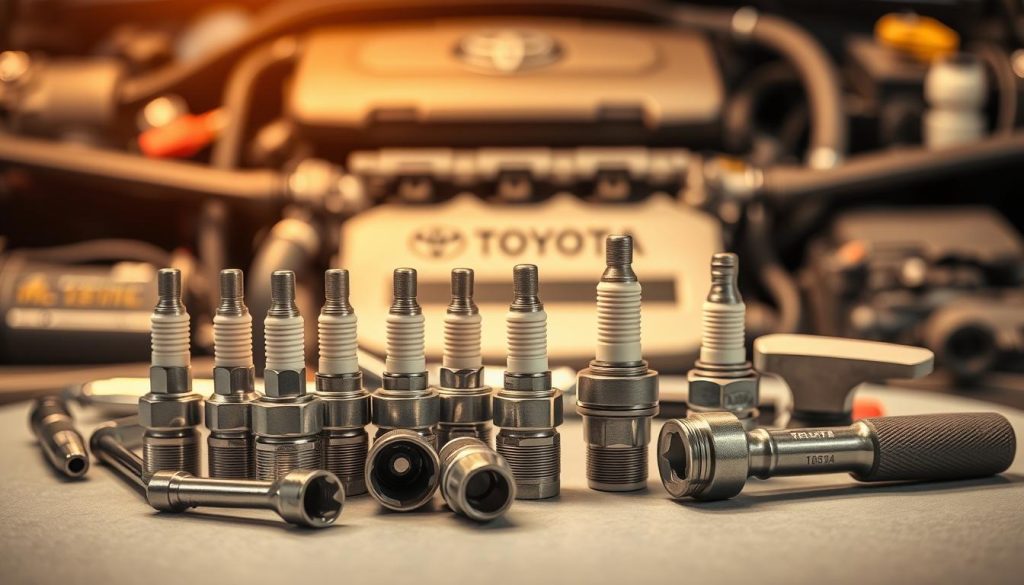
A torque wrench is optional but recommended. It ensures spark plugs are tightened correctly. A basic beam-type torque wrench is good for DIYers, while mechanics might prefer a click-type model.
Optional Specialized Tools for Easier Replacement
While basic tools work, specialized tools can make the job easier. Spark plug boot pliers help remove ignition coil boots safely. They offer better grip than trying to pull by hand.
For tight spaces, a swivel socket or universal joint adapter is helpful. These tools allow access to spark plugs at awkward angles.
A thread chaser tool is good for older Toyotas with thread damage. It cleans threads without removing metal. Dielectric grease makes boot removal easier and protects electrical connections.
| Tool Category | Basic Tools | Specialized Tools | Approximate Cost | Necessity Level |
|---|---|---|---|---|
| Safety Equipment | Gloves, Safety Glasses | Mechanic’s Arm Sleeves | $10-25 | Essential |
| Hand Tools | Socket Set, Ratchet, Extensions | Swivel Sockets, Flexible Extensions | $30-100 | Essential |
| Spark Plug Tools | Spark Plug Socket | Boot Pliers, Gap Gauge | $15-40 | Essential/Optional |
| Precision Tools | Torque Wrench | Thread Chaser, Anti-seize Compound | $25-80 | Recommended/Optional |
Types of Spark Plugs Compatible with Toyota Vehicles
Choosing the right spark plugs for your Toyota is key to its performance and upkeep. The right plugs ensure your engine runs well, uses fuel efficiently, and lasts longer. Toyota’s engines are built to last, so picking the right spark plugs is crucial.
Toyota cars use advanced spark plug technology. But, the best type for your car depends on your model, how you drive, and what you expect from your car. Let’s look at the different options to help you choose the right one for your car.
OEM vs. Aftermarket Spark Plugs
When it’s time to replace your spark plugs, you’ll have to decide between OEM and aftermarket options. Toyota OEM spark plugs are made just like the ones in your car. They fit perfectly and meet Toyota’s high standards. They’re known for reliable performance.
Aftermarket plugs from brands like NGK, Denso, and Bosch are also good. They’re often made by the same companies that make Toyota parts. Make sure they match your car’s specs for gap size, heat range, and thread dimensions.
OEM and quality aftermarket plugs can cost $2-5 each. This adds up for bigger engines. For most drivers, aftermarket plugs work great. But, if you want the best, Toyota OEM parts are the way to go.
Copper vs. Platinum vs. Iridium Spark Plugs
Toyota cars use three main types of spark plugs. Copper spark plugs are the most affordable but need replacing often. They last 20,000-30,000 miles.
Platinum spark plugs last longer, up to 100,000 miles. They’re a good choice for many Toyota models. Double platinum plugs last even longer, with platinum on both electrodes.
Iridium spark plugs are the top choice for most Toyotas. They’re made with a very hard iridium center electrode. They last over 100,000 miles. They’re more expensive but offer great performance and longevity.
Recommended Spark Plugs for Popular Toyota Models
Finding the right spark plugs for your Toyota is easy with the right info. For the Toyota Camry with 4-cylinder engines (2018-present), the Denso SC20HR11 iridium plug is a good choice. V6 Camry models use the NGK DILKAR7C11 or Toyota OEM 90919-01253.
Toyota Corolla owners (2014-present) should look at the NGK DILKAR7A11 iridium plug. RAV4 models with the 2.5L engine do well with the Denso SC20HR11. Tacoma trucks with the 3.5L V6 need NGK LFR6C11 plugs, while 4-cylinder versions use NGK DILKAR6D11.
Toyota Highlander V6 models benefit from NGK DILKAR7A11 iridium plugs. For Toyota hybrids like the Prius, use specialized plugs like the NGK DILKAR7C11H. Always check your owner’s manual or talk to a Toyota parts specialist for the exact part number for your car.
Preparing Your Toyota for Spark Plug Replacement
Before you start your Toyota spark plug installation, take time to prepare well. A careful approach keeps you safe and helps the job go smoothly. It also helps avoid mistakes and lets you focus on the technical parts of the job.
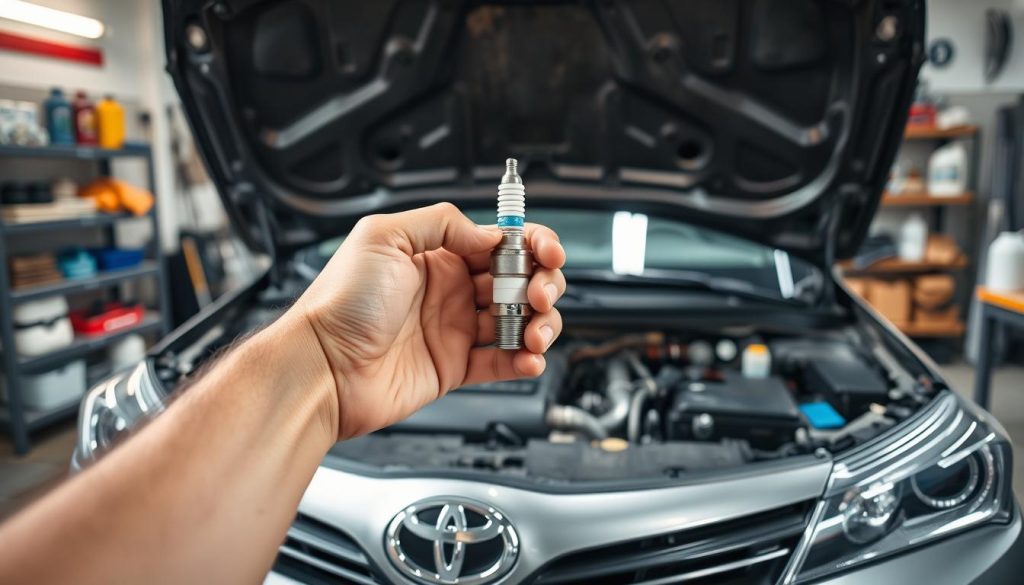
Safety Precautions Before Starting
Always put safety first when working on your Toyota. First, park your car on a flat surface and engage the parking brake. This keeps the car still while you work.
Wait until the engine is completely cool before you start. Engines stay hot for hours after driving. This can cause burns. Wait at least two hours after driving.
Before starting, disconnect the negative battery terminal. This step prevents electrical shocks or accidental engine starts. Use insulated tools to avoid sparks.
Wear safety glasses and gloves for protection. Safety glasses guard your eyes from debris and chemicals. Gloves protect your hands from cuts and burns. Make sure your workspace is well-ventilated and have a fire extinguisher ready.
Gathering Necessary Materials and Documentation
Having the right materials and information is key for a successful Toyota spark plug installation. First, find your vehicle’s owner’s manual or service documentation. These guides have important details like:
- Correct spark plug specifications for your Toyota model
- Proper torque settings for installation
- Recommended replacement intervals
- Model-specific access instructions
Make a list of everything you need before starting. Your list should include:
- Correct replacement spark plugs for your Toyota model
- Spark plug socket with extension
- Torque wrench calibrated for precise installation
- Anti-seize compound (if recommended for your model)
- Dielectric grease for ignition coil connections
- Clean shop rags for cleanup
Check your new spark plugs against the old ones before installing. Make sure they match in size, reach, and heat range. This step prevents engine damage. Take photos with your phone before removing parts to ensure correct reassembly.
Keep your workspace organized by placing removed parts in order. This method ensures no parts are lost or misplaced during reassembly.
Locating Spark Plugs in Different Toyota Engine Types
Finding spark plugs in your Toyota’s engine bay changes a lot based on the engine type. Each engine type has its own way of making it easy or hard to replace spark plugs. Knowing your engine’s layout before starting can save you a lot of time and trouble.
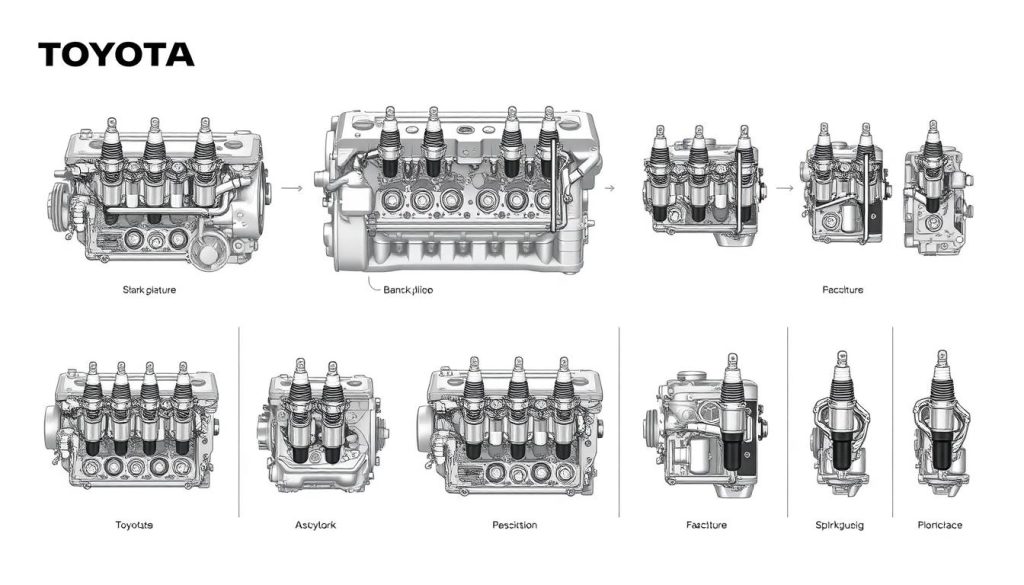
4-Cylinder Engine Layout
Toyota’s 4-cylinder engines are found in cars like the Corolla, Camry, and RAV4. They have spark plugs lined up along the engine’s top. This makes them easier to get to than other engine types.
To find these spark plugs, first take off any plastic covers held by clips or small bolts. Then, you’ll see four ignition coils in a row. These coils hide the spark plugs underneath them.
The cylinders are numbered 1-4 from the front to the back. In tighter engine bays, like newer RAV4s, you might need longer socket extensions to reach the plugs. Remove each plug one at a time to avoid confusion when putting them back.
V6 Engine Layout
Toyota V6 engines, like those in the Camry V6, Highlander, Avalon, and Tacoma, have a more complex setup. They have two banks of cylinders in a “V” shape, with three spark plugs on each side.
The front bank is easy to access. But, the rear bank plugs are harder to get to because they’re against the firewall. Models like the V6 Tacoma might need you to remove intake manifold braces or other parts to reach these plugs.
To avoid mistakes, label each ignition coil with its cylinder number as you take them off. This helps prevent ignition timing problems when putting everything back together. For the hard-to-reach rear plugs, using thin-wall spark plug sockets can help a lot.
V8 Engine Layout
Toyota’s V8 engines, found in the Tundra, Land Cruiser, and Sequoia, have eight spark plugs in two banks of four. These engines are big and can be hard to work on.
The spark plugs are arranged in a V shape, with some being easier to reach than others. For example, in the 5.7L Tundra V8, the passenger side plugs are easier to get to. But, the driver’s side plugs might need you to remove intake parts or fuel rails.
Experts suggest using flexible socket extensions and swivel joints to get into tight spaces in these engines. It’s also important to check the plug gaps, especially in high-performance V8 engines. Use a gap tool to make sure the gaps are correct before installing the plugs. Here’s a table showing how hard it is to access Toyota V8 spark plugs:
| Cylinder Position | Access Difficulty | Required Tools | Components to Remove |
|---|---|---|---|
| Front Bank (1-4) | Moderate | Socket wrench, extensions | Engine cover, air intake |
| Rear Bank (5-8) | Difficult | Swivel socket, long extensions | Intake manifold (sometimes) |
| Corner Cylinders | Very Difficult | Flexible socket tools | Multiple components |
Complete Toyota Spark Plug Replacement Process
The Toyota spark plug replacement process has several key steps. These steps help restore your engine’s performance and efficiency. Even if you’re new to DIY, following these steps can help you replace spark plugs successfully.
Removing Engine Covers and Accessing Spark Plugs
Modern Toyota engines have protective plastic covers. These covers must be removed to access the spark plugs. Start by making sure your engine is cool before you begin.
Find the mounting points of your engine cover, usually held by 10mm bolts. Use a socket wrench to remove these bolts by turning counterclockwise. Loosen them with your wrench first, then remove them by hand for better control.
After removing all fasteners, lift the engine cover straight up and away. Set it aside safely. With the cover off, you’ll see the ignition coils above each spark plug.
Dealing with Plastic Engine Covers
Toyota engine covers use different fasteners like bolts, push-pins, or plastic clips. Use the right tool for each to avoid damage. Covers can get brittle with age and heat, so remove them gently. If a cover is stuck, look for hidden fasteners instead of forcing it, which could cause damage.
Accessing Hard-to-Reach Plugs
Some Toyota models have spark plugs in hard-to-reach spots. For rear plugs, you might need to remove parts like intake manifold bracing. Use extension bars with your socket wrench for these spots. Flexible-head ratchets can also help around obstacles.
Organizing Removed Components

Organize all removed parts to ensure correct reassembly. Use a clean towel or cardboard sheet divided into sections for each cylinder. Place each part in its area, keeping the original order. Taking photos before disassembly helps during reassembly. Use magnetic trays for small fasteners to keep them organized.
Disconnecting Ignition Coils Safely
Ignition coils are crucial for modern Toyota engines. Remove them carefully to avoid damage. Start by disconnecting the electrical connector by pressing the locking tab and pulling straight out.
Next, find the mounting bolt for each coil. Most use a 10mm bolt. Remove this bolt and organize it with the other parts. This is important to avoid performance issues later.
Grasp the ignition coil firmly and pull it straight up. If stuck, don’t force it. Instead, ensure all fasteners are removed and try wiggling it gently.
Check each coil for signs of damage or oil intrusion. If you find damaged connectors, use zip-ties or replace them with new parts (Toyota connector part #90980-11885 is common).
Removing Old Spark Plugs Properly
Removing old spark plugs prevents damage to your engine. Use the correct spark plug socket, usually 5/8″ or 16mm. Attach it to a 6-inch extension and ratchet handle to reach the plug.
Before applying force, ensure the socket is seated on the spark plug. Turn counterclockwise to break the initial torque. Apply force in a straight line to prevent thread damage.
Once loosened, remove the ratchet handle and continue unscrewing by hand. This reduces the risk of dropping debris into the cylinder. Lift the plug out carefully, ensuring no debris falls into the cylinder.
Examine each removed plug for signs of engine problems. Normal plugs have light tan or grayish deposits. Black deposits indicate a rich fuel mixture, while white deposits suggest overheating. Oil-fouled plugs may indicate seal or valve guide issues.
Installing New Spark Plugs Correctly
Proper installation of new spark plugs is crucial for your Toyota engine’s performance. Start by removing the protective plastic cover from your new spark plug. If your plugs aren’t pre-gapped, check the gap with a gap tool before installation.
Apply a small amount of anti-seize compound to the threads if recommended. This makes future removal easier. Be careful not to get compound on the electrode tip, as it can affect performance.
Always start threading new spark plugs by hand to prevent cross-threading. Insert the plug into the socket, then lower it into the spark plug well. Turn clockwise by hand until the threads engage properly.
Once hand-tight, use a torque wrench set to Toyota’s specified torque value. This is usually between 13-22 ft-lbs. Proper torque is essential; too loose can cause poor performance or plug ejection, while too tight can damage the plug or cylinder head threads.
After installation, apply a small amount of dielectric grease to the ceramic insulator of the plug. This prevents moisture intrusion and ensures a solid electrical connection. Press the ignition coil back into position over the new plug until fully seated, then reinstall and tighten the mounting bolt.
Proper Torque Specifications for Toyota Spark Plugs
Knowing the right torque for Toyota spark plugs is key to avoiding engine damage and keeping your car running well. It’s important to apply the correct amount of force when installing spark plugs. Too much or too little can lead to serious engine problems.
Understanding Torque Requirements
Torque specs are not random numbers. They are set by Toyota engineers to ensure a tight seal between the spark plug and cylinder head. Over-torquing can damage the aluminum cylinder head, leading to costly repairs or even needing a new engine.
Under-torquing can cause leaks, plug ejection, or ongoing performance issues. That’s why a good torque wrench is a must, not a choice, for installing spark plugs.
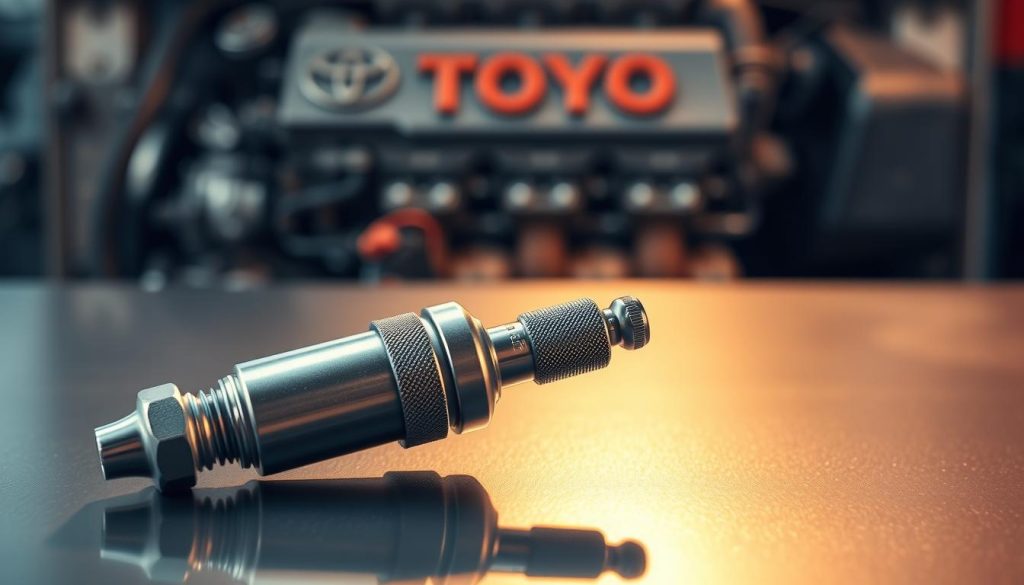
Different spark plug materials need different torque values. Also, using thread lubricants like anti-seize compound (recommended by Toyota for some models) can lower the needed torque by about 20%. Always check if your model needs anti-seize before you start.
Model-Specific Torque Settings
Toyota cars have different torque specs based on engine type and model year. Here are the correct values for some popular models:
| Toyota Model | Engine Type | Model Years | Torque (ft-lbs) | Torque (Nm) |
|---|---|---|---|---|
| Camry | 2.5L 4-cylinder | 2018-2023 | 13-17 | 18-23 |
| Corolla | 1.8L 4-cylinder | 2014-2023 | 13-18 | 18-24 |
| RAV4 | 2.5L 4-cylinder | 2019-2023 | 14-17 | 19-23 |
| Tacoma | 3.5L V6 | 2016-2023 | 18-20 | 24-27 |
Newer Toyota models with aluminum-block engines often need lower torque than older iron-block engines. If your model isn’t listed, check your factory service manual or Toyota’s official website for the exact specs.
Getting the torque right is crucial for a successful spark plug installation. Taking the time to do it correctly will help your engine run smoothly for many miles.
Reinstalling Ignition Coils and Engine Components
Reconnecting ignition coils and putting back engine parts is key to finishing your Toyota spark plug job. After putting in new spark plugs, making sure these parts are correctly installed is vital. This ensures your engine runs well without any electrical problems or misfires. Let’s look at how to reconnect these important parts right and check if everything is tight.
Proper Connection Techniques
When putting back ignition coils in your Toyota, making sure they fit right is crucial. Start by applying a bit of dielectric grease inside each coil boot. This keeps moisture out and helps seal the coil to the spark plug better.
Align the ignition coil boot with the spark plug terminal and press it down until it clicks. Don’t twist or rock it, as this can harm the spring inside that touches the spark plug.
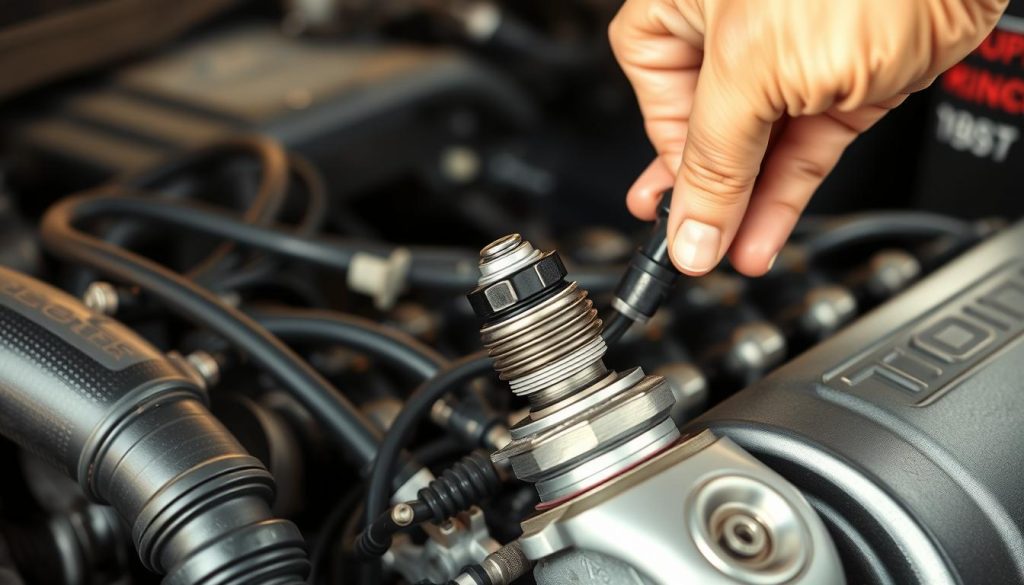
Then, connect the electrical connector to each coil, making sure the tab clicks. This keeps the connector from coming loose while the engine runs. Tighten the mounting bolts to the right amount—usually 7-10 ft-lbs for Toyotas. Too tight can harm the coil or where it’s mounted.
Verifying Secure Installation
After putting everything back, it’s important to check if it’s all secure. Start by gently pulling on each ignition coil to see if it’s in place. The coils should not move or feel loose.
Make sure all electrical connectors are snug with their tabs locked. A loose connection can cause check engine lights or misfires. Also, check that all mounting bolts are there and tightened right.
Before closing up, scan the engine bay for any tools or parts left out. These can damage the engine when it starts. Then, put back any engine covers or decorative parts, making sure not to over-tighten plastic parts.
This check is a crucial Toyota spark plug tip to avoid performance problems. Taking a few extra minutes to double-check can save a lot of time later. It ensures your spark plugs work as they should.
Testing Your Toyota After Spark Plug Replacement
The last step in any Toyota spark plug DIY project is testing your car’s performance. After replacing your spark plugs, it’s important to test your car. This ensures your hard work pays off and your Toyota runs smoothly.
Initial Engine Start and Monitoring
Before starting your Toyota’s engine, do a quick safety check. Make sure all tools are gone, the battery is connected right, and no flammable stuff is near.
When you’re ready, turn the key and listen. A good spark plug replacement should start your engine smoothly. Check the idle quality too. It should be steady without any rough spots.
Normal vs. Concerning Observations:It’s normal for the check engine light to flash at start-up. But if it stays on, it might mean a problem with the ignition coils or spark plugs.
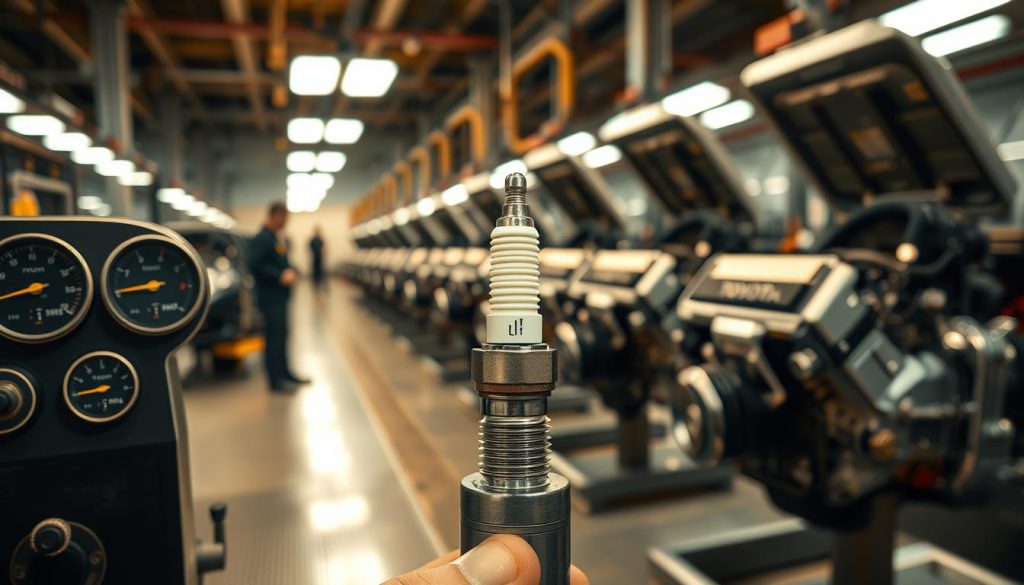
Some smoke or a slight smell is okay at first. It’s just oil or fingerprints burning off. But if it keeps going, you need to check it out.
Watch the engine temperature gauge. It should go up and then stay steady. If it doesn’t, it could mean a problem with the spark plugs.
Performance Verification Process
After a successful start, test your car’s performance. Take it for a drive in different conditions to check how it’s doing.
Make sure it accelerates smoothly. New spark plugs should make the car feel snappy. If it hesitates, it might be a gap or connection issue.
Also, watch your fuel economy. New spark plugs can make your car use less gas. Here’s a simple table to track your progress:
| Performance Aspect | Before Replacement | After Replacement | Expected Improvement |
|---|---|---|---|
| Idle Quality | Rough/Uneven | Smooth/Steady | Significant |
| Acceleration | Hesitation/Lag | Responsive/Crisp | Noticeable |
| Fuel Economy | Baseline MPG | Improved MPG | 2-3% Better |
| Engine Noise | Knocking/Pinging | Smooth Operation | Moderate |
For a full check, inspect the spark plugs again after 500-1000 miles. This can show if there are any bigger problems with your engine.
Common Mistakes to Avoid During Toyota Spark Plug Replacement
Replacing Toyota spark plugs is a DIY task many can handle. But, knowing the common mistakes can save your engine and wallet. Many owners face problems that could be avoided with the right knowledge. Let’s look at the most common errors and how to avoid them.
Installation Errors That Damage Engines
Improper installation can damage your Toyota’s engine. Cross-threading is a major mistake. It happens when a spark plug is inserted wrong and then forced into the cylinder head.
Always thread spark plugs by hand first. If you feel resistance, stop and realign. The threads should turn smoothly. Forcing a cross-threaded plug can damage the engine threads, leading to expensive repairs.
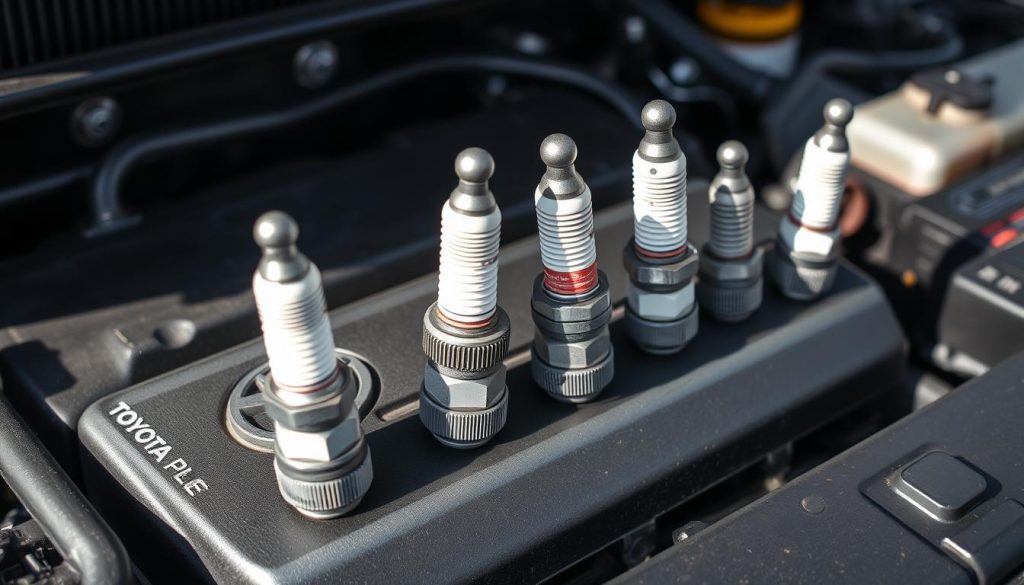
Another mistake is over-torquing spark plugs. Using too much torque can strip threads or break the plug. Always use a torque wrench set to Toyota’s recommended specifications.
Be careful not to drop tools or debris into the cylinder. Foreign objects can cause serious damage. Cover the opening with a clean towel when not installing the plug.
Using the wrong spark plugs can also cause problems. Incorrect heat ranges or designs can lead to engine issues. Always check your Toyota’s manual or a reliable parts database for the correct specifications.
Overlooked Steps in the Replacement Process
Some steps are often overlooked, leading to performance issues or plug failure. One step is checking the gap on new spark plugs. Even pre-gapped plugs should be verified with a feeler gauge.
Many owners skip checking the spark plug wells for oil or debris. Oil indicates a leaking valve cover gasket. Debris can fall into the cylinder or compromise the ignition coil seal.
Applying dielectric grease to ignition coil boots is often missed. This prevents moisture intrusion and makes removal easier. Without it, boots can stick to plugs, causing damage.
Creating a checklist for your Toyota spark plug replacement can help. It ensures you don’t miss any steps. A systematic approach prevents errors and makes the task more efficient.
Troubleshooting Post-Replacement Issues
Even with the right steps, Toyota owners might face problems after replacing spark plugs. These issues don’t mean you did anything wrong. Even pros sometimes run into these problems. Knowing how to fix them quickly is key to getting your Toyota running well again.
Engine Misfires After Replacement
Engine misfires are common after replacing spark plugs in Toyotas. If your car idles roughly or accelerates unevenly, start by finding the misfiring cylinder. Use an OBD-II scanner to read trouble codes.
Look at the cylinder for possible causes. First, check if the spark plug is correctly gapped. Even pre-gapped plugs can shift. Next, make sure the ignition coil is fully seated and its connector is tight.
Check the coil boot for damage or carbon tracking. Black streaks on the insulator can cause misfires. If issues continue, test the ignition coil’s resistance with a multimeter, following your Toyota’s manual.
Check Engine Light Problems
A check engine light after replacing spark plugs can be worrying but is often simple to fix. Use an OBD-II scanner to get specific trouble codes. P0300 means random misfires, while P030X codes point to specific cylinder problems.
Some codes might just need clearing, as the computer detected temporary issues. Toyota vehicles often need an idle relearning procedure after spark plug replacement, especially on newer models.
Knock sensor codes (P0325-P0330) might mean the wrong plug heat range or not enough torque. Always make sure you’ve installed the correct plug type for your Toyota model.
Performance Issues After Installation
If your Toyota has a rough idle, hesitation when accelerating, or uses more fuel after spark plug replacement, start with the basics. Check that all plugs are correctly gapped and are the right type for your engine.
Look for vacuum leaks that might have happened during replacement. Listen for hissing sounds and check for loose or damaged vacuum lines. On older Toyotas with distributor systems, check if ignition timing is okay.
Aftermarket plugs might cause problems, even if they seem compatible. If issues keep happening, try switching back to Toyota OEM spark plugs. They’re made specifically for your vehicle’s ignition system.
Special Considerations for Toyota Hybrid Models
Replacing spark plugs in Toyota hybrids is different from regular cars. The special setup and high-voltage parts make it more challenging. It’s important to know these differences for a safe and right replacement.
Prius and Other Hybrid Spark Plug Access
Models like the Prius, Camry Hybrid, and RAV4 Hybrid have smaller engine areas. This makes it harder to get to the spark plugs. In the Prius, you’ll need to take out the air intake system first.
For some Prius models, like the third generation, you also have to remove the wiper cowl. This step is crucial for the right tool placement. It adds to the Toyota spark plug change process but is necessary.
The Camry Hybrid has a bit better access, while the RAV4 Hybrid is in between. For all, using spark plug sockets with flexible extensions or universal joints helps a lot.
Hybrid engines work differently than regular ones. This means you should use the spark plugs recommended by the manufacturer. Hybrids might need specific plugs because of their unique cycles.
Safety Precautions for Hybrid Systems
Working on a hybrid vehicle requires extra care because of the high-voltage system. Before starting your Toyota spark plug DIY project, follow these steps to power down the hybrid system:
First, turn off the ignition and remove the key or smart key. Then, disconnect the 12V auxiliary battery in the trunk by removing the negative terminal. Wait at least 10 minutes for the high-voltage capacitors to discharge before you can start.
Never touch or disconnect the orange high-voltage cables or parts. They carry enough electricity to be dangerous. Many Toyota hybrids have a service plug for extra safety. Check your owner’s manual for where it is.
Wear insulated gloves when near hybrid parts, and don’t do a Toyota spark plug change if you see damaged high-voltage parts. If you see damage, get help from a professional right away. Hybrid cars have two electrical systems, and you must be careful with both.
Maintaining Your New Spark Plugs for Longevity
To make your Toyota spark plugs last longer, pay attention to how you drive and check them regularly. With the right Toyota spark plug maintenance, you can go longer between replacements. This keeps your engine running well for a longer time.
How you drive and when you check your plugs really matters. It can affect how long they last.
Driving Habits That Extend Spark Plug Life
Your daily driving habits affect your spark plugs. Short trips don’t let the engine get hot enough, leading to buildup on plugs. Drive on highways more to keep the engine hot and clean the plugs.
Driving hard, especially with quick starts, wears out plugs faster. Make sure to warm up your car, especially in cold weather. This helps prevent damage and buildup.
Using high-quality fuel is key for plug longevity. Choose the best gasoline to reduce buildup. Also, keep air filters clean and get your fuel system checked regularly. This helps your engine burn fuel better and keeps plugs in good shape.
Regular Inspection Schedule
Regular checks are crucial for keeping your spark plugs in top shape. For standard plugs, check every 30,000 miles. For iridium or platinum, do it at 60,000 miles.
When you check, take out one plug to see how it’s doing. Look at the electrodes for wear or buildup. This tells you a lot about your engine’s health.
Take pictures of your plugs to track their condition over time. This helps you see how they’re wearing and spot problems early. By watching your plugs and engine performance, you can catch issues before they get worse.
Cost Analysis: DIY vs. Professional Toyota Spark Plug Replacement
Looking into the cost of replacing Toyota spark plugs shows if doing it yourself saves money. Many Toyota owners think about the cost before deciding to do it themselves. We’ll look at both options to help you decide based on your budget, skills, and time.
Price Breakdown of DIY Replacement
Replacing spark plugs yourself starts with buying parts and tools. Spark plug prices change based on type and quality. Copper plugs cost $2-6 each, while iridium plugs are $8-20 each.
For a 4-cylinder Toyota Corolla or Camry, you need four plugs. This costs $8-80, depending on the type. V6 models like the Highlander or some Camry versions need six plugs, raising the cost to $12-120.
First-time DIYers also need to think about tool costs. A basic socket set with a spark plug socket is $30-50. A torque wrench adds $20-60. Don’t forget to buy anti-seize compound ($5) and dielectric grease ($6) to protect connections and ensure proper installation.
When you add up DIY costs for a Toyota spark plug DIY project, remember the value of tools. For example, a complete spark plug replacement for a Toyota Camry might cost:
- Iridium spark plugs (4): $60
- Basic tools (one-time purchase): $80
- Supplies: $12
- Total: $152
The real benefit is that tools can be used again for future maintenance, lowering the cost per job.
Professional Service Costs by Toyota Model
Professional spark plug replacement costs vary by Toyota model and service location. Dealerships usually charge more but may include extra benefits like full inspections.
Labor costs are the biggest part of professional services, with rates from $90-150 per hour. Most Toyota models need 1-2 hours of labor for a full replacement, depending on engine access.
| Toyota Model | Dealer Cost | Independent Shop | Time Required |
|---|---|---|---|
| Corolla (4-cylinder) | $180-240 | $140-180 | 1-1.5 hours |
| Camry (4-cylinder) | $200-260 | $150-200 | 1-1.5 hours |
| RAV4 | $220-280 | $160-220 | 1.5-2 hours |
| Tacoma/Highlander (V6) | $300-400 | $220-300 | 2-3 hours |
Professional services often include more than just parts and labor. Technicians do computer resets, diagnostic scans, and visual checks of other parts. These extras can find problems before they get worse.
When comparing costs, remember that professional services usually come with a warranty on parts and labor. This gives you peace of mind that DIY work can’t offer, especially if you’re not sure about your mechanical skills.
The average DIY savings is $80-250, depending on your Toyota model. But this doesn’t count the time you’ll spend, which can be a lot for first-timers or those working on V6 or V8 engines.
Conclusion
Learning to replace spark plugs in your Toyota is a skill that boosts your car’s performance and reliability. This guide has shown you how to do it, from spotting warning signs to picking the right parts.
Keeping your spark plugs in check offers quick benefits you’ll see every time you drive. Your engine will run better, you’ll save on gas, and you’ll cut down on emissions. Upgrading your spark plugs can make driving more enjoyable and save you money.
Whether you choose to do it yourself or get a pro to help, knowing how works for your car. The tools and methods in this guide work for most Toyotas, but some details might differ.
Always follow the replacement schedule for your Toyota. Keep your car’s manual nearby and refer to this guide for future maintenance.
By taking the time to maintain your spark plugs, you’re making your Toyota last longer and stay reliable. Your engine is crucial—treat it well with quality spark plugs installed right.
FAQ
How often should I replace spark plugs in my Toyota?
The replacement time depends on your car’s model and plug type. Newer Toyotas with iridium plugs need a change every 100,000-120,000 miles. Older models with copper plugs might need a replacement every 30,000-60,000 miles. Always check your owner’s manual for the best time to replace them for your car. If you drive a lot in city traffic or extreme weather, you might need to replace them sooner.
What are the signs that my Toyota needs new spark plugs?
Signs include a rough engine idle, hard starting, and poor fuel economy. You might also feel the engine “stumble” or hesitate when accelerating. If your check engine light turns on, it could mean your spark plugs need attention. These problems usually get worse as the spark plugs wear out.
Can I replace Toyota spark plugs myself, or should I take it to a mechanic?
If you have basic mechanical skills and the right tools, you can replace spark plugs yourself. Four-cylinder engines like those in the Corolla and Camry are easy to work on. But V6 and V8 engines are harder due to tight spaces and more parts in the way. If you’re not sure or have a complex engine, it’s better to let a professional do it.
What tools do I need to replace spark plugs in my Toyota?
You’ll need a ratchet, extensions, a spark plug socket, and a torque wrench. Don’t forget safety glasses and gloves. You’ll also need the correct spark plugs, anti-seize compound, and dielectric grease. Tools like spark plug boot pliers and swivel sockets can make the job easier. A spark plug gap tool is needed if your plugs aren’t pre-gapped.
What type of spark plugs should I use in my Toyota?
Use the type your owner’s manual recommends. Most Toyotas come with iridium or platinum plugs. OEM plugs from Toyota dealerships are good, but aftermarket options from NGK, Denso, and Bosch are also great and often cheaper. Don’t switch from iridium to copper plugs, as it can hurt performance and shorten their life.
How much does Toyota spark plug replacement cost?
DIY replacement costs – for a set of four spark plugs, depending on the type. Professional service at a dealership can cost 0-0+, depending on your model and location. Independent shops charge 20-40% less than dealerships. V6 and V8 engines cost more because they need more labor and plugs.
What’s the correct torque specification for Toyota spark plugs?
Torque specs vary by model, but most Toyotas need 13-22 ft-lbs. Always use a torque wrench to avoid damaging the threads or causing leaks. Your owner’s manual will have the exact spec for your vehicle. If using anti-seize compound, reduce the torque by about 20%.
Can I upgrade my Toyota’s spark plugs to improve performance?
Upgrading to platinum or iridium plugs can improve fuel economy and performance. But if your Toyota already has iridium plugs, aftermarket “premium” plugs won’t make a big difference. Always choose the correct heat range for your replacement plugs.
What should I do if I cross-thread a spark plug in my Toyota?
Stop immediately if you feel resistance when threading in a new plug. Cross-threading can damage the threads badly. If caught early, carefully back out the plug and try again. If threads are damaged, you might need a repair kit or professional help. In severe cases, the cylinder head might need to be removed, which is expensive. Always start threading by hand to avoid cross-threading.
Are there special considerations for replacing spark plugs in Toyota hybrid vehicles?
Yes. Toyota hybrids like the Prius need extra safety steps because of their high-voltage systems. Make sure the vehicle is completely off and follow the shutdown procedure in your manual. Wait at least 10 minutes before working on the engine. Some hybrids have unique engine layouts that make spark plug access harder, so check model-specific guides before starting.
How do I check if my new spark plugs are working properly?
Start your Toyota and listen for a smooth engine. There should be no misfires or unusual noises. Take it for a test drive to check acceleration and idle quality. If you notice any problems or the check engine light comes on, there might be an installation issue. A proper installation should improve your car’s performance compared to worn plugs.
What’s the difference between Toyota OEM and aftermarket spark plugs?
Toyota OEM plugs are the same as those installed at the factory, ensuring perfect compatibility and performance. They’re made by manufacturers like Denso or NGK but with Toyota branding. Aftermarket plugs from these manufacturers (without Toyota branding) are often cheaper but have the same specs. High-quality aftermarket plugs from reputable brands perform just as well as OEM plugs, making them a cost-effective choice for most Toyota owners.
